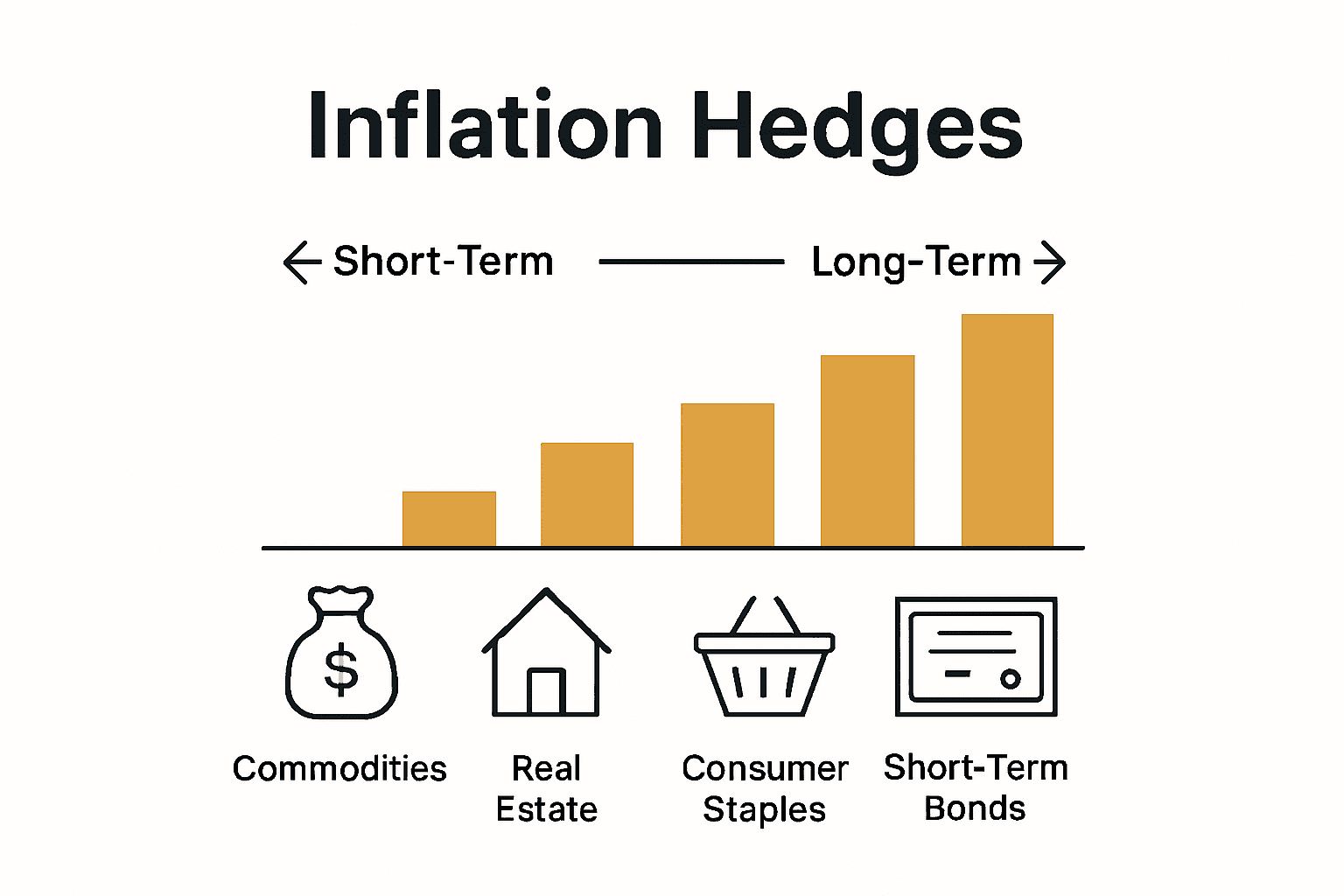Did you know that inflation can eat away up to 30 percent of your savings over a single decade? Rising prices quietly reduce the real value of your hard-earned money, making future expenses even harder to predict. Understanding which investments offer true protection becomes vital if you want to keep your wealth intact. This article uncovers how different assets can act as a shield against inflation, helping you make wiser choices in an unpredictable economy.
Key Takeaways
| Point | Details |
|---|---|
| Inflation Hedging | Effective inflation hedging requires a diversified portfolio across asset classes to combat rising prices effectively. |
| Asset Classes | Key inflation hedge assets include commodities, real estate, consumer staples, and short-term bonds, each offering unique benefits. |
| Investment Strategy | Successful inflation protection involves understanding liquidity, risk premiums, and potential transaction costs when selecting assets. |
| Limitations | Investors must navigate challenges such as basis risk, liquidity issues, and taxation complexities that can undermine hedging effectiveness. |
Table of Contents
- Defining Inflation Hedging Investments
- Types Of Inflation Hedge Assets Explained
- How Inflation Hedges Work In Practice
- Key Risks And Limitations To Consider
- Comparing Inflation Hedges To Alternative Strategies
Defining Inflation Hedging Investments
An inflation hedge is a strategic investment designed to protect your financial assets against the erosive effects of rising prices. According to research from SmartAsset, these investments are most effective when unexpected inflation occurs, helping investors maintain their purchasing power during economic uncertainty.
At its core, an inflation hedge functions like a financial shield. When general price levels increase, these investments aim to grow in value at a rate that matches or exceeds inflation, preventing your wealth from losing real value. As Wikipedia’s finance research indicates, no single asset class provides a permanent protection against unexpected inflation, which means diversification becomes crucial.


Investors typically consider several asset classes as potential inflation hedges:
- Commodities: Raw materials like gold, silver, and oil
- Real Estate: Property investments that can appreciate with inflation
- Consumer Staples Stocks: Companies selling essential goods
- Short-Term Bonds: Investments that adjust quickly to changing economic conditions
The effectiveness of an inflation hedge depends on multiple factors, including investment horizon, economic regime, and precise timing.
Successful investors understand that inflation protection requires a nuanced, adaptive approach rather than a one-size-fits-all strategy.
Types of Inflation Hedge Assets Explained
Understanding the various types of inflation hedge assets is crucial for protecting your investment portfolio from the eroding effects of rising prices. According to Wikipedia’s research on inflation hedging, different asset classes respond uniquely to inflation surprises, making strategic diversification essential for effective protection.
Let’s explore the primary categories of inflation hedge assets:
Here’s a comparison of common inflation hedge assets:
| Asset Class | Typical Role | Short-Term Protection | Long-Term Benefits |
|---|---|---|---|
| Commodities | Buffer vs. inflation | Strong | Moderate volatile returns |
| Real Estate | Income & appreciation | Moderate | Strong rental income growth |
| Consumer Staples | Defensive stocks | Moderate | Steady resilient profits |
| Short-Term Bonds | Flexible capital | Limited | Modest quick adjustment |
| Nominal Bonds | Traditional holding | Weak | Potential recovery over time |
-
Commodities: These raw materials often provide partial protection after inflation surprises. Gold, silver, oil, and agricultural products typically adjust quickly to price changes, offering a natural buffer against economic fluctuations.
-
Real Estate: Property investments can serve as powerful inflation hedges. Rental income and property values tend to increase alongside inflation, providing investors with a dynamic protection mechanism.
-
Stocks: While equities can underperform immediately after inflation surprises, they may deliver long-term investment premiums. Consumer staples and companies with strong pricing power are particularly resilient.
Interesting nuances emerge when examining these assets. Commodities might offer short-term protection, while stocks can provide long-term value preservation. Nominal bonds, though traditionally considered less effective, can recover as yields accrue over time.


Explore our guide on alternative investment options to develop a comprehensive inflation protection strategy that balances risk and potential returns.
How Inflation Hedges Work in Practice
Inflation hedging is more than just selecting assets – it’s about understanding how different investments respond to economic changes. According to Wikipedia’s research on inflation hedging, investors can measure an asset’s effectiveness by calculating its inflation beta, which reveals how closely an investment’s returns correlate with inflation rates.
Practically speaking, an ideal inflation hedge demonstrates an inflation beta close to 1, indicating that the asset’s value moves in near-perfect synchronization with rising prices. When this happens, your investment maintains its purchasing power, protecting you from the erosive effects of inflation. However, achieving this perfect alignment isn’t straightforward – multiple factors influence an asset’s hedging performance.
Key considerations in practical inflation hedging include:
- Liquidity: How easily can you buy or sell the asset?
- Risk Premiums: What additional returns compensate for potential volatility?
- Transaction Costs: How much does it cost to maintain the investment?
- Index Lag: How quickly does the asset adjust to inflation changes?
Learn more about alternative investment strategies that can help you build a robust inflation-resistant portfolio. The most successful investors don’t just pick hedges – they create a dynamic, adaptable strategy that responds to changing economic landscapes.
Key Risks and Limitations to Consider
While inflation hedging strategies offer protection, they aren’t without significant challenges. According to Wikipedia’s research on inflation hedges, investors must carefully navigate multiple complex limitations that can undermine their investment protection strategies.
Basis risk emerges as a critical concern in inflation hedging. This occurs when the inflation index used in your investment doesn’t precisely match your personal spending patterns. Imagine investing in an asset that tracks a national inflation rate, but your individual expenses diverge significantly from that average – suddenly, your hedge becomes less effective.
Key risks investors should be aware of include:
- Liquidity Challenges: Some inflation-linked instruments can be difficult to buy or sell quickly
- Embedded Risk Premiums: Additional costs that might reduce potential returns
- Transaction Costs: Fees associated with managing and maintaining inflation hedge investments
- Taxation Complexities: Potential tax implications that could erode investment gains
- Implementation Frictions: Practical difficulties in perfectly matching inflation protection strategies
Understand financial risk management strategies to develop a more comprehensive approach to protecting your investments. Smart investors recognize that no single strategy offers complete protection – diversification and continuous adaptation remain crucial in managing inflation risks.
Comparing Inflation Hedges to Alternative Strategies
Inflation hedging strategies represent just one approach to protecting your investment portfolio. According to Wikipedia’s research on long-horizon investment techniques, sophisticated investors often create comprehensive protection strategies by combining multiple asset types rather than relying on a single investment instrument.
The key difference between inflation hedges and alternative strategies lies in their approach to managing financial risk. While traditional inflation hedges focus specifically on countering price increases, alternative strategies offer broader protection mechanisms. These might include diversified investment portfolios that spread risk across different asset classes, providing more flexible and potentially more robust financial protection.
Comparing strategies reveals several important distinctions:
- Inflation Hedges: Directly target price level changes
- Diversification Strategies: Spread risk across multiple investments
- Dynamic Asset Allocation: Continuously adjust portfolio composition
- Sector Rotation: Move between different economic sectors
- Macro Hedging: Protect against broader economic shifts
Explore alternative investments that can complement your inflation protection strategy to build a more resilient financial approach. The most effective investors understand that no single strategy offers complete protection – flexibility and continuous adaptation are key to managing economic uncertainties.
Take Control of Your Wealth With Smart Inflation Protection
Feeling unsure if your savings are truly secure as inflation rises? Many investors worry about keeping up with unpredictable price increases and the risk of losing real value in their assets. This article highlighted the need for adaptive inflation hedging strategies and pointed out the importance of asset diversification, liquidity, and managing risks like basis risk and transaction costs. Relying on guesswork or outdated methods can leave you exposed when the economy shifts.
If you want real protection, expert guidance is essential. Discover how our advice at finblog.com can help you navigate inflation threats with confidence. Ready to move from uncertainty to strategic action? Connect with our team today and explore our comprehensive risk management guide or alternative investment strategies. Learn how to build a resilient portfolio and safeguard your future. Visit finblog.com to start your journey now before another financial surprise puts your investments at risk.
Frequently Asked Questions
What is an inflation hedge?
An inflation hedge is a strategic investment that protects financial assets against the erosive effects of rising prices, aiming to maintain purchasing power during economic uncertainty.
What types of assets are considered effective inflation hedges?
Common inflation hedge assets include commodities (like gold and oil), real estate, consumer staples stocks, short-term bonds, and nominal bonds, each offering unique benefits and risks.
How does inflation hedging work in practice?
Inflation hedging involves selecting investments that correlate closely with inflation rates. Ideal hedges should have an inflation beta close to 1, ensuring that their value increases as prices rise, protecting purchasing power.
What are the key risks associated with inflation hedging investments?
Key risks include basis risk (when inflation indices don’t match personal spending), liquidity challenges, transaction costs, and taxation complexities, all of which can undermine the effectiveness of hedging strategies.










